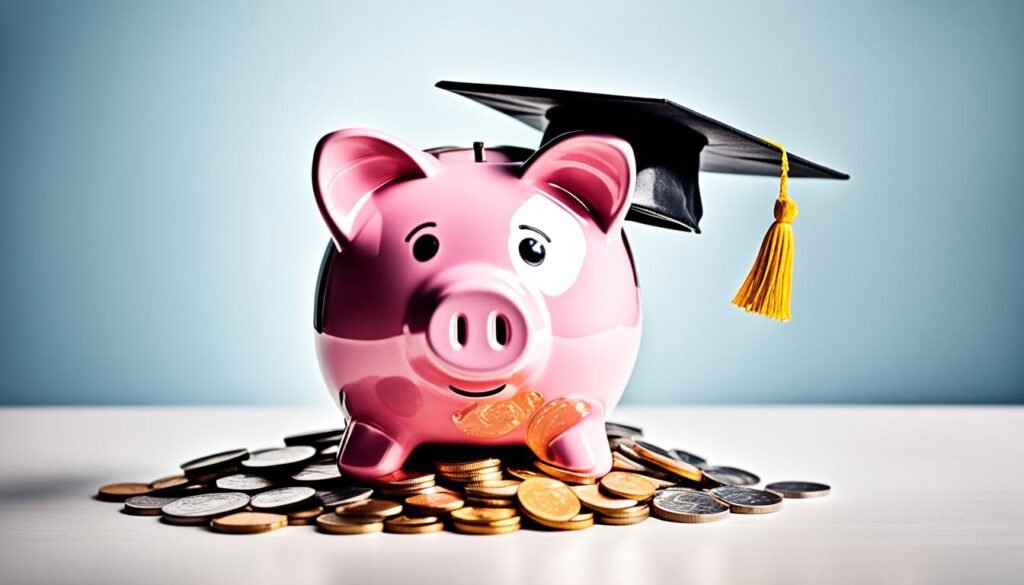Table of Contents
ToggleIn 2018, the average college graduate had $29,200 in student loans. It takes nearly 20 years for a bachelor’s degree holder to pay off their loans. But, you can pay off your student debt smartly with the right strategies.
Key Takeaways
- Explore options for making extra payments towards the principal of your student loans to become debt-free years earlier.
- Refinance your loans to secure a lower interest rate, which can save you money in the long run.
- Enroll in an income-driven repayment plan to ensure your monthly payments are manageable.
- Automate your payments and recertifications to stay on top of your student loan obligations.
- Take advantage of tax benefits and military benefits, if applicable, to reduce the burden of your student debt.
Make Extra Payments Towards the Principal
Making extra payments on your student loans can help you pay them off faster. This approach can cut down the interest you pay and make you debt-free sooner.
Also Read: What Are Credit Terms?
Instruct Your Servicer to Apply Overpayments Directly to the Principal
When you pay more on your student loans, tell your servicer to put the extra towards the principal. This way, the extra money goes straight to reducing what you owe. It helps you pay off the loan faster and saves you money in the long run.
The Power of $100 Extra per Month
Even a small extra payment can make a big difference. For instance, adding $100 per month to a $10,000 loan at 4.5% interest can shave off about five and a half years from your repayment time. This payment towards the principal can save you thousands in interest and speed up your financial freedom.
Also Read: Medical Research Advances: Innovations That Could Change Your Life
“The fastest way to pay off student loans is to pay more than the minimum each month.”
Refinance Your Loans for a Lower Interest Rate
Refinancing your student loans can help you lower your interest rate and save money. By combining your loans into one, you might get a better interest rate. This could mean big savings over time.
Also Read: How Career Education Loans Can Help You Achieve Your Professional Goals?
Refinancing Replaces Multiple Loans with a Single Loan
Student loan refinancing means taking all your student loans and putting them into one new loan. This loan usually has a lower interest rate. So, you could pay less each month and save a lot of money over the years.
For instance, turning a $50,000 loan with an 8.5% rate into a 6% rate on a 7-year term saves about $15,000. But, your monthly payment would go up.
Qualifying for Student Loan Refinancing
To get refinanced student loans, you need a good credit score, steady income, and a debt-to-income ratio under 50%. Lenders check if you can handle the new loan. You’ll likely need to provide things like pay stubs, tax returns, and details about your current loans.
Also Read: What Are The Common Loan Terms?
| Criteria | Requirement |
|---|---|
| Credit Score | High 600s |
| Income | Steady Source |
| Debt-to-Income Ratio | Below 50% |
“Refinancing can be a game-changer for borrowers looking to lower their interest rate on student loans and save money over the long run.”
Enroll in an Income-Driven Repayment Plan
If you’re finding it hard to pay your student loans, think about an income-driven repayment (IDR) plan. These plans can lower your monthly payments based on what you earn and your family size. The SAVE plan is a new option that might give you the lowest payments and help you forgive your loan faster if you borrowed a small amount.
With the SAVE plan, your payment could be as low as $0 if your income is very low. Plus, any unpaid interest won’t add up, so your loan won’t grow. This makes it easier to pay off your loan and become debt-free faster.
Choosing an IDR plan is a wise move for lowering student loan payments and aiming for income-driven repayment plan forgiveness. The right plan can help you free up money each month for other goals.
Also Read: What Are The Most Common Types Of Structured Finance Instruments?
| Income-Driven Repayment Plan | Monthly Payment | Forgiveness Timeline |
|---|---|---|
| SAVE | As low as $0 | 10-20 years |
| Income-Based Repayment (IBR) | 10-15% of discretionary income | 20-25 years |
| Pay As You Earn (PAYE) | 10% of discretionary income | 20 years |
| Revised Pay As You Earn (REPAYE) | 10% of discretionary income | 20-25 years |
To start, reach out to your student loan servicer about federal student loan repayment plans that could reduce your payments. Looking into your options can help you find the best income-driven repayment plan for your financial situation.
Student Loan Repayment
Missing payments on student loans can lead to serious problems. If you keep missing payments, your loan will go into default. This can cause your wages to be garnished, your tax refunds to be taken, and you’ll lose eligibility for federal aid. But, there are ways to get out of default and take back control of your loans.
Explore Loan Rehabilitation and Consolidation
Loan rehabilitation is one way to get out of default. It means making regular payments to remove the default from your credit report. Another option is loan consolidation. This combines several federal loans into one with a fixed interest rate.
Discover Forgiveness Programs
If you’re having trouble paying your loans, you might be eligible for loan forgiveness programs. Programs like the Public Service Loan Forgiveness (PSLF) can erase part of your loans if you work in public service and make certain payments.
| Option | Description | Eligibility |
|---|---|---|
| Loan Rehabilitation | Allows you to remove the default status from your credit report by making a series of on-time payments | Available for federal student loans in default |
| Loan Consolidation | Combines multiple federal loans into a single new loan with a fixed interest rate | Available for federal student loans, including those in default |
| Loan Forgiveness Programs | Can help you have a portion of your loans forgiven, such as the Public Service Loan Forgiveness (PSLF) program | Varies by program, but often requires working in a public service job and making a minimum number of qualifying payments |
Understanding the risks of student loan default and looking into loan rehabilitation, consolidation, and forgiveness programs can help you manage your loans. This way, you can work towards becoming debt-free.
Automate Payments and Recertifications

Making your student loan payments easier can really help your finances. Consider using autopay and automatic recertification for income-driven plans. These strategies can make a big difference.
Autopay for Student Loans
Lenders often give a discount of up to 0.25% for automatic monthly payments, or autopay. This can save you money over time and make sure you never miss a payment. By using autopay for student loans, you get consistent payments and peace of mind.
Automatic Recertification for Income-Driven Plans
If you’re on an income-driven plan, you can let your income and household size be automatically checked every year. This keeps your payments in line with your income, avoiding sudden increases. It saves you time and effort in managing your loans.
Using these automated options gives you interest rate discounts for student loans and makes repaying your loans easier. This can help you pay off your loans faster.
Take Advantage of Tax Benefits
Managing your student loan debt can be easier with tax benefits. One key benefit is the student loan interest deduction.
If your income and filing status match certain criteria, you can deduct up to $2,500 of your student loan interest. This can lower your taxes and give you more money.
Claim the Student Loan Interest Deduction
To get the student loan interest deduction, you must meet certain requirements:
- Your modified adjusted gross income (MAGI) must be less than $85,000 if you’re single, or $170,000 if you’re married and filing together.
- You must have paid interest on a qualified student loan, which includes federal and private loans for education.
- You cannot be claimed as a dependent on someone else’s tax return.
Claiming this deduction can lower your taxable income and reduce your taxes. It’s wise to talk to a tax expert or use tax software to make the most of tax benefits for student loans.
Staying updated on tax-saving tips for student loans can greatly improve your finances. Using these strategies in your repayment plan can help you pay off your loans faster.
Utilize Military Benefits

If you’ve served in the military, you can use your service to help with your student loan debt. The Public Service Loan Forgiveness (PSLF) program is great for PSLF for military members. It also offers a student loan interest rate cap for military through the Servicemembers Civil Relief Act (SCRA).
Qualify for Public Service Loan Forgiveness (PSLF)
The PSLF program forgives your federal student loans after 120 qualifying payments while you work in public service. This includes active-duty military service. It can wipe out your student debt and give you a big financial boost.
Benefit from the Servicemembers Civil Relief Act (SCRA)
The servicemembers benefits for student loans under the SCRA cap your interest at 6% on loans taken out before your military service. This can save you a lot of money over time.
Using these military benefits can help you manage your student loans better. It could even help you pay off your debt faster. These programs are a big help for PSLF for military members and servicemembers benefits for student loans.
Allocate “Found Money” Towards Loans

Want to pay off your student loans quicker? Use unexpected money for your loan repayment. This means using money from bonuses, tax refunds, or other surprises. Even 50% of these funds can greatly shorten your loan payoff time.
Consider treating these surprise funds as if they’re not part of your usual budget. Don’t spend them right away. Instead, put them straight towards your student loan. This approach not only speeds up paying off student loans but also cuts down on interest over time.
- Identify potential windfalls: Keep an eye out for things like tax refunds, work bonuses, inheritances, or other unexpected cash infusions.
- Allocate at least 50% towards loans: When you receive a windfall, resist the urge to spend it all. Instead, put at least half towards paying down student loans.
- Make extra principal-only payments: Instruct your loan servicer to apply the extra payments directly to the loan principal, not just the next month’s payment.
| Scenario | Savings |
|---|---|
| $5,000 tax refund, 50% allocated to loans | $3,000 in interest savings over the life of the loan |
| $10,000 work bonus, 100% allocated to loans | $6,000 in interest savings over the life of the loan |
Using unexpected money to pay off your student loans can speed up your debt-free journey. This smart move can help you pay off student loans faster and save thousands in interest over time.
“Using windfalls to pay down student loans is one of the most effective ways to become debt-free years earlier.”
Explore Employer Assistance Programs
Some employers now offer student loan repayment assistance benefits to attract and keep top talent. These employer student loan assistance programs help by paying up to $10,000 towards your loans over a few years.
If your job or group offers a student loan repayment program, don’t miss out. These student loan repayment benefits can greatly help you manage your debt. They can even help you pay off your loans faster.
Maximize Your Employer’s Contributions
To get the most from your employer’s student loan repayment assistance, do the following:
- Learn what you need to qualify and how much they contribute
- Sign up for the program and give the needed documents
- Use automatic payments to pay on time and get the most from the employer’s help
Using these employer student loan assistance programs can ease your student debt. This lets you focus more on your financial goals.
| Employer Student Loan Assistance Benefits | Average Contribution |
|---|---|
| Student Loan Repayment Assistance | Up to $10,000 over 5 years |
| Tuition Reimbursement | Up to $5,250 per year |
| Employer-Sponsored Loan Refinancing | Variable, based on program terms |
“Employer student loan assistance programs can be a game-changer for recent graduates struggling with their student debt. Taking advantage of these benefits can significantly accelerate your path to financial freedom.”
By using employer student loan assistance and other smart ways, you can manage your student debt well. This helps you reach your financial goals faster.
Also Read: What Are The Common Loan Terms?
Conclusion
Using a mix of smart student loan repayment strategies can help you pay off your debt early. You can make extra payments, refinance for a lower rate, or join income-driven plans. These options give you ways to handle your student loans better.
Keep in touch with your loan servicer and set up automatic payments. Use any extra money you find to pay off your loans. This will help you make progress in student loan repayment strategies, managing student loan debt, and paying off student loans. With discipline and the right tools, you can beat your student debt and look forward to a debt-free future.
By using these wise strategies, you can take back control of your money. This will lessen the weight of your student loan debt and help you reach your financial goals. Stay on track, keep up with the latest info, and act early to manage your student loans well health education assistance loan may be eligible for forgiveness income and family size federal direct.
FAQs
Q: What are the different repayment options available for federal student loans?
A: There are several repayment options available for federal student loans, including the Standard Repayment Plan, Graduated Repayment Plan, Extended Repayment Plan, Income-Driven Repayment Plans, and the Public Service Loan Forgiveness Program. Each option is designed to cater to different financial situations and repayment capabilities.
Q: How can I learn about repayment options for my federal student loan?
A: You can learn about repayment options by visiting the Department of Education’s website or contacting your loan servicer. They can provide detailed information about all the available repayment plans and help you choose the best one based on your financial situation.
Q: What should I do if I’m struggling to make payments on my federal student loans?
A: If you’re struggling to make payments, consider contacting your loan servicer to discuss alternative repayment options. You may qualify for income-driven repayment plans that adjust your monthly payment based on your income, or you might explore deferment or forbearance options temporarily.
Q: What is loan consolidation and how can it benefit me as a borrower?
A: Loan consolidation allows you to combine multiple federal student loans into a single loan with one monthly payment. This can simplify your repayment process and may qualify you for different repayment options, including a longer repayment period, which can lower your monthly payment amount.
Q: Can I get my student loans forgiven, and how do I qualify for student loan forgiveness?
A: Yes, there are several forgiveness options available, such as the Public Service Loan Forgiveness Program and Teacher Loan Forgiveness. To qualify, you often need to meet specific criteria, such as working in a qualifying job or making a certain number of payments under a qualifying repayment plan.
Q: How does the loan simulator work to help me repay my student loans?
A: The loan simulator is a tool that helps you explore different repayment scenarios based on your income and loan balance. By inputting your information, you can see how different repayment options, payment amounts, and forgiveness programs might affect your loan repayment strategy.
Q: What are some common loan scams that student loan borrowers should watch out for?
A: Common loan scams often involve companies charging fees for services that can be obtained for free, such as loan forgiveness applications or repayment plan changes. Always contact your loan servicer directly or visit the Department of Education’s website for legitimate assistance and information.
Q: How can I contact my loan servicer if I have questions about my federal student loans?
A: You can contact your loan servicer by visiting their website or calling their customer service number. It’s important to have your loan information handy to receive the most accurate assistance regarding your repayment options or any other inquiries.
Q: What is the difference between federal family education loans (FFEL) and direct loans?
A: Federal Family Education Loans (FFEL) were previously offered by private lenders and guaranteed by the federal government, while Direct Loans are issued directly by the Department of Education. Direct Loans generally have more flexible repayment options and benefits, such as eligibility for income-driven repayment plans and loan forgiveness programs.





